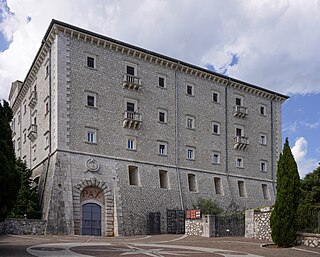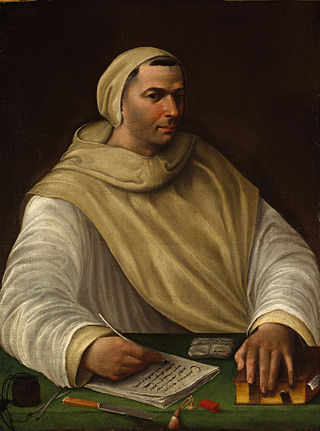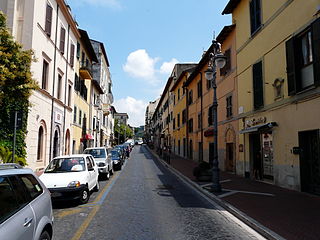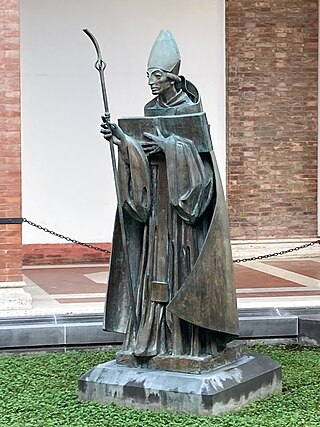
Monte Cassino is a rocky hill about 130 kilometres (80 mi) southeast of Rome, in the Latin Valley, Italy, 2 kilometres west of Cassino and at an elevation of 520 m (1,710 ft). Site of the Roman town of Casinum, it is widely known for its abbey, the first house of the Benedictine Order, having been established by Benedict of Nursia himself around 529. It was for the community of Monte Cassino that the Rule of Saint Benedict was composed.

The Hieronymites or Jeronimites, also formally known as the Order of Saint Jerome, is a Catholic cloistered religious order and a common name for several congregations of hermit monks living according to the Rule of Saint Augustine, though the role principle of their lives is that of the 5th-century hermit and biblical scholar Jerome.

The Olivetans, formally known as the Order of Our Lady of Mount Olivet, are a monastic order. They were founded in 1313 and recognised in 1344. They use the Rule of Saint Benedict and are a member of the Benedictine Confederation, where they are also known as the Olivetan Congregation, but are distinguished from the Benedictines in their white habit and centralized organisation. They use the post-nominals 'OSB Oliv'.

Grottaferrata is a comune (municipality) in the Metropolitan City of Rome Capital, situated on the lower slopes of the Alban Hills, 20 kilometres southeast of Rome. It has grown up around the Abbey of Santa Maria di Grottaferrata, founded in 1004. Nearby communes include Frascati, Rocca di Papa, Marino and Rome.

Casamari Abbey is a Cistercian abbey in the Province of Frosinone, Lazio, Italy, about 10 kilometers east-south-east of Veroli.

Fruttuaria is an abbey in the territory of San Benigno Canavese, about twenty kilometers north of Turin, northern Italy.

The Abbey of Saint-Victor is a former abbey that was founded during the late Roman period in Marseille in the south of France, named after the local soldier saint and martyr, Victor of Marseilles.

Bobbio Abbey is a monastery founded by Irish Saint Columbanus in 614, around which later grew up the town of Bobbio, in the province of Piacenza, Emilia-Romagna, Italy. It is dedicated to Saint Columbanus. It was famous as a centre of resistance to Arianism and as one of the greatest libraries in the Middle Ages. The abbey was dissolved under the French administration in 1803, although many of the buildings remain in other uses.

Sant'Anselmo all'Aventino is a complex located on the Piazza Cavalieri di Malta Square on the Aventine Hill in Rome's Ripa rione and overseen by the Benedictine Confederation and the Abbot Primate. The Sant'Anselmo complex, also known as the "Primatial Abbey of Sant'Anselmo" because it is the residence of the Abbot Primate, consists of: an ecclesiastical residential college known as the "College of Sant'Anselmo" ; a university known as the "Pontifical Athenaeum of Saint Anselm" ; the "Church of Sant'Anselmo" ; and the curial headquarters of the "Benedictine Confederation" and Abbot Primate. The complex and associated institutions are named in honor of the Benedictine monk Saint Anselm of Canterbury.

The Abbey of Sant'Antimo is a former Benedictine monastery located in Castelnuovo dell'Abate, in the comune of Montalcino, Tuscany, central Italy. It is approximately 10 km from Montalcino about 9 km from the Via Francigena, the pilgrim route to Rome. After many years of disuse, the abbey was reoccupied in 1992 by a small community of Premonstratensian Canons Regular. Since January 2016, the occupants are a community of monks of the Olivetan Benedictine order.

Albaro is an affluent residential neighbourhood of the Italian city of Genoa, located 3 kilometres (1.9 mi) east of the city centre. It was formerly an independent comune, named San Francesco d'Albaro, included in the city of Genoa in 1873. At present, together with the neighbourhoods of Foce and San Martino d'Albaro is part of the Genoa's city VIII Municipio.

The Territorial abbey of La Trinità della Cava, commonly known as Badia di Cava, is a Benedictine territorial abbey located near Cava de' Tirreni, in the province of Salerno, southern Italy. It stands in a gorge of the Finestre Hills.

Santo Stefano is a church in Genoa, northern Italy. Located on a hill overlooking the central Via XX Settembre, it is one of the most outstanding examples of Romanesque architecture in the city.

Novalesa Abbey is a Benedictine monastery in the Metropolitan City of Turin, Piedmont, Italy. It was founded in 726, and dedicated to Saint Peter and Saint Andrew.

Belmont Abbey, in Herefordshire, England, is a Catholic Benedictine monastery that forms part of the English Benedictine Congregation. It stands on a small hill overlooking the city of Hereford to the east, with views across to the Black Mountains in Wales to the west. The 19th century Abbey also serves as a parish church.

The Abbey of Santa Maria di Rovegnano is a Cistercian monastic complex in the comune of Milan, Lombardy, northern Italy. The borgo that has developed round the abbey was once an independent commune called Chiaravalle Milanese, now included in Milan and referred to as the Chiaravalle district.

The Abbey of Santa Giustina is a 10th-century Benedictine abbey complex located in front of the Prato della Valle in central Padua, region of Veneto, Italy. Adjacent to the former monastery is the basilica church of Santa Giustina, initially built in the 6th century, but whose present form derives from a 17th-century reconstruction.
The Abbey of San Giusto is a former Cistercian monastery located in the valley of the river Marta approximately 4 km south of Tuscania, Province of Viterbo, Italy.

The church of Santa Maria delle Grazie in Brescia is located on at the west end of Via Elia Capriolo, where it intersects with the Via delle Grazie. Built in the 16th century and remodeled in the 17th century, it still retains much of its artwork by major regional artists, including one of its three canvases by Moretto. The other two are now held at the Pinacoteca Tosio Martinengo. The interior is richly decorated in Baroque fashion. Adjacent to the church is the Sanctuary of Santa Maria delle Grazie, a neo-gothic work.

San Pietro is an ancient Roman Catholic church and former monastery located on piazza San Pietro in central Gubbio, region of Umbria, in Italy. The church which displays architectural elements from many centuries, from Romanesque to the Renaissance, as well as housing prominent artworks; the monastery now houses the civic Biblioteca Comunale Sperelliana.






















